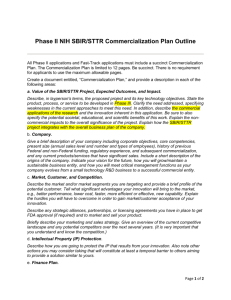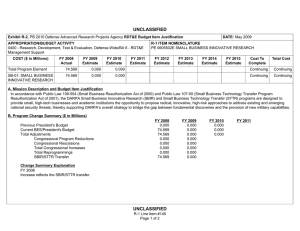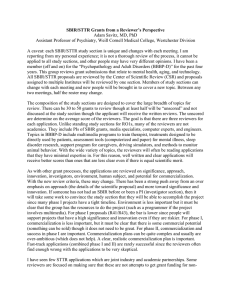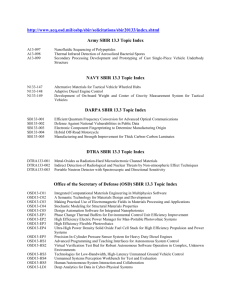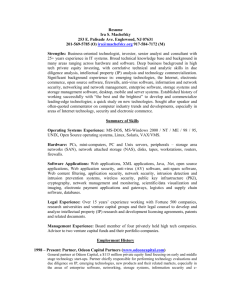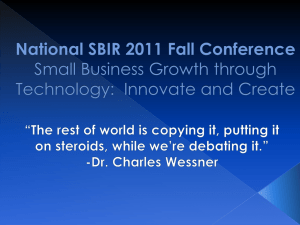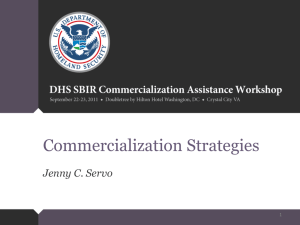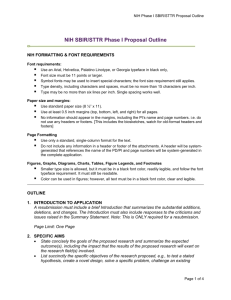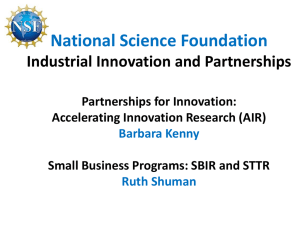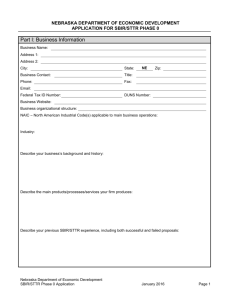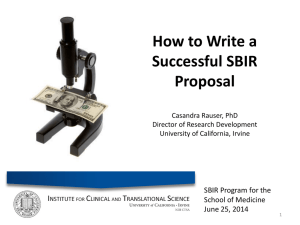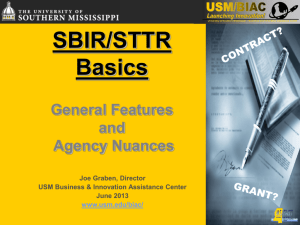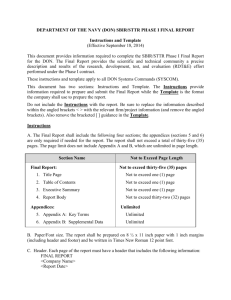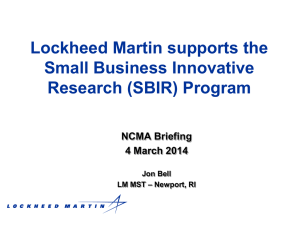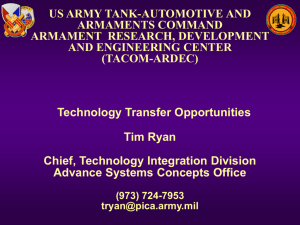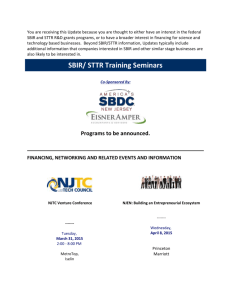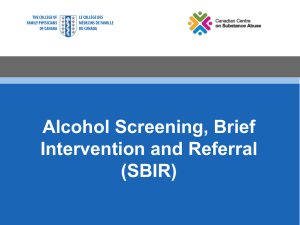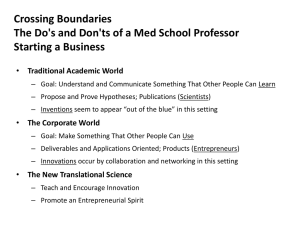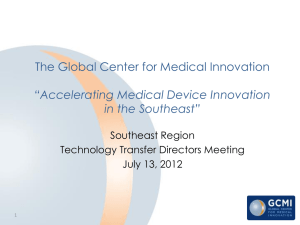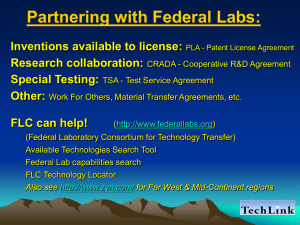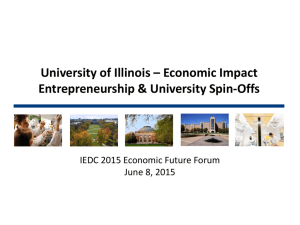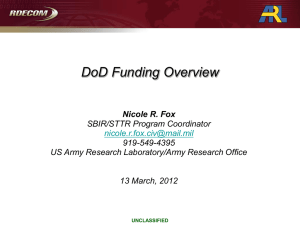Jeff Gronberg SBIR Presentation
advertisement
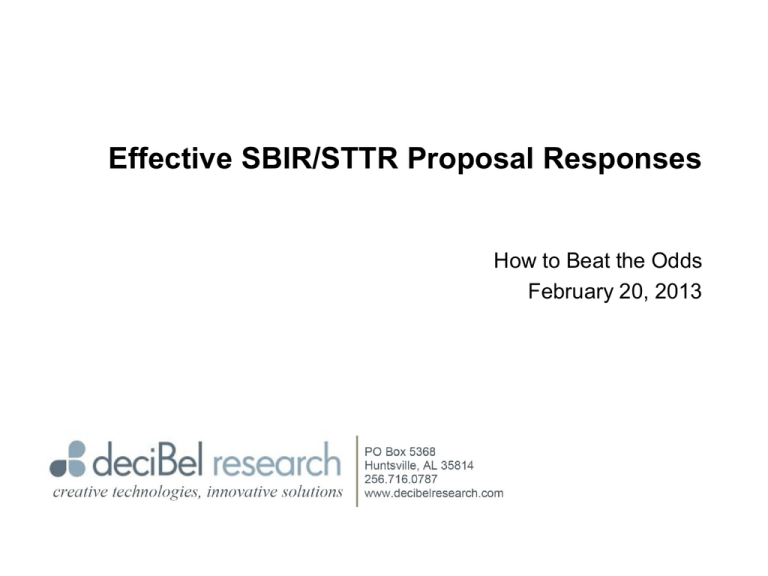
Effective SBIR/STTR Proposal Responses How to Beat the Odds February 20, 2013 Why worry about winning SBIR? Typical win rate for a Phase I is 10% Good SBIR companies can perform at 30-70% SBIR/STTR provides interesting work, new customer contacts and nice revenue Phase III provides tremendous opportunities for Sole Source contracts SBIR/STTR is getting more competitive, don’t waste precious resources by submitting a poor proposal Huntsville/North Alabama should be more competitive with California, Boston, New York, Texas and other SBIR centers of excellence creative technologies, innovative solutions 2 How to Improve Your Odds Best Approach: Help to create a topic! Use SBIR as a path to solve a customer problem Next Best: Propose on topics where you know the TPOC Past or current relationships are a huge differentiator Must: Talk to the TPOC/Alternate Understand the problem they are trying to solve Understand the program they are targeting the technology for Try to determine likely commercialization or proposal partners Ask how many awards they are likely to make Determine what other approaches they have tried Provide an overview of your approach and see if they “bite” Familiarization is key to a successful proposal, technology itself rarely wins the day. creative technologies, innovative solutions 3 So You’ve Decided to Write Solve their problem (not a problem, or your problem) Never educate them on their problem, or tell them they are off-base Be innovative but also practical The proposal is a selling document, not a scientific paper Demonstrate a clear understanding of the problem Provide a clear, concise and compelling central idea/concept as your approach to solving the problem Show benefits and demonstrate ability (proof) Guide the reviewer to a clear, believable solution creative technologies, innovative solutions 4 Technical Proposal Requirements All Topics below must be covered in this order Identification and Significance of the Problem or Opportunity Phase I Technical Objectives Phase I Work Plan • With Task Schedule (Separate Schedules for Base and Option, if applicable) Related Work Relationship with Future Research or Research and Development Commercialization Strategy Key Personnel Facilities/Equipment Subcontracts/Consultants Prior/Current, or Pending Support of Similar Proposals or Awards Additionally, deciBel Research requires the following: • Deliverables – Include Final Report as required in solicitation – Monthly progress reports – Other deliverables as determined by solution creative technologies, innovative solutions 5 Well Don’t Just Start Writing USE A TEMPLATE (CORRECTLY) Create an outline or storyboard for your concept Outline serves as your guide for telling the reviewer your story Create graphics/figures/tables (at least conceptually) before writing Have a figure or table on every page (at least every other) Use bulleted lists and call out boxes liberally Use bold or other consistent formatting to draw attention to key words/statements Create a schedule for your work as part of the outline Clearly include any subcontractor efforts and ensure “flow” Writing without a plan is a recipe for failure creative technologies, innovative solutions 6 Evaluation Criteria Soundness, technical merit, and innovation of the proposed approach and its incremental progress toward topic or subtopic solution The qualifications of the proposed principal/key investigators, supporting staff and consultants; Qualifications include not only the ability to perform the research and development, but also the ability to commercialize the results Potential for commercial (Government or private sector) application and the benefits expected to accrue from this commercialization Pay attention to how your proposal will be evaluated creative technologies, innovative solutions 7 Teaming Team to increase your chance of winning Technical capability Relationship Commercialization Partner Determine potential team members early Get NDA and SOW done ASAP Look at possibility of getting a letter of support vs. subcontract in Phase I, especially for large companies Understand restrictions/requirements on work share Be clear on expectations If including subs, most effort should be done before writing Teaming should increase your chance of winning. creative technologies, innovative solutions 8 Requirements for Cost Proposal Proposals are auditable by DCAA prior to award Most awards will be Firm Fixed Price Writer needs to provide: Personnel required for effort Number of hours (or LOE, % work) by person Any special material or equipment costs with quotes as back up Travel requirements (number of trips, number of people, number of days, location) Subcontract POC (technical & contracts) Subcontract Statement of Work (description, schedule, deliverables) Dollar ceiling for subcontractor (if less than previous table) Must plan well, ODC and subs are critical drivers creative technologies, innovative solutions 9 Key Personnel Key Personnel are critical to success Best to have a PhD as the PI If not, they better have great credentials Tailor the resume/CV to the topic! Highlight published works (books, papers, presentations, etc.) and similar research initiatives Demonstrate that the key personnel are experienced and capable creative technologies, innovative solutions 10 Commercialization Showing clear path is critical Use subs or letters of support to demonstrate path Commercialization does not mean actual “commercial” application DoD or other Government/Civil agency is valid If possible, directly target prime integrator for the program that created the requirement “Productization” of the idea is important Pay attention to “ilities” Best to indicate multiple possibilities/markets Commercialization can be difficult to write, but is a major evaluation criteria creative technologies, innovative solutions 11 Summary SBIR/STTR is a great program that we as a community need to be more successfully exploiting Encourage you to write a good proposal to an appropriate topic Involve help early and often Encourage customers to use SBIR/STTR to solve problems Pay attention to the problem and don’t forget about key personnel and commercialization SBIR/STTR provides a perfect mechanism to do R&D and generate $ creative technologies, innovative solutions 12
